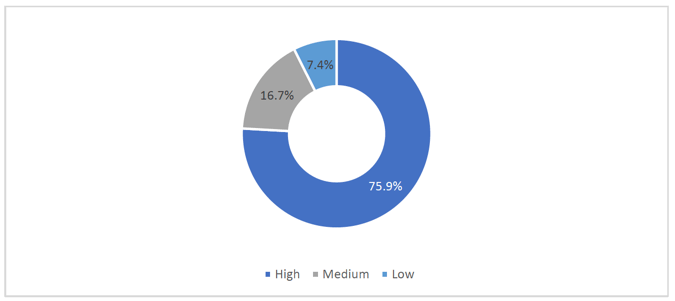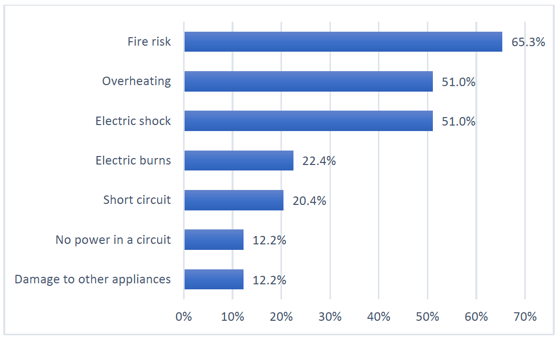Regulation of electricians in Scotland: research report
Research conducted by Pye Tait to independently assess the evidence and build a business case to determine if regulation is required.
4. Risk from Defective Electrical Installations
4.1 Risk Assessment
We have adopted a four-stage risk assessment[31] that requires the following steps:
1. Identifying the hazard (and its scope)
2. Deciding who or what is at risk
3. Assessing the risk
4. Recommending action
If necessary, a fifth stage could be added in future research to review the risk against previous data (i.e. this report).
All risk assessments have their limitations. This one does not deal with individual cases of defective electrical installations. Neither does it address the type of domestic location or all potential risks. Instead it looks broadly at defective electrical installations in domestic settings across Scotland.
4.2 The hazard/scope
The scope of the research focuses on electrical installations in Scotland. This was refined during project scoping discussions and interviews and a development webinar to target domestic settings only (i.e. excluding all electrical installations in commercial, industrial or agricultural settings).
The hazard was further refined to exclude defective wiring and components in electrical appliances and components which could not be adapted or rewired by the installing electrician.
The hazard was therefore, as stated above, defined as being defective electrical installations and the scope limited to domestic settings in Scotland.
4.3 Who/what is at risk
The second stage of the assessment was to develop an agreed list of potential areas of risk from defective electrical installations in domestic settings in Scotland and to include them in the question set for the Call for Evidence. These are:
- Risk to life
- Risk of electrical shock or electrical burns to a person
- Risk of fire/overheating
- Risk of damage to other appliances
- Risk of a short circuit
- Risk of no power to the circuit
The aim was then to use the Call for Evidence to determine if there are other significant data that should be collected for inclusion in the analysis, as well as to undertake an initial data collection on risk and harm.
In the Call for Evidence, non-electrician respondents were asked to rate the risk to human safety of the defective installation and explain their answer.
The aim of this was to determine uninformed perceptions of the gravest possible outcomes and in doing so it was established that over three quarters (76%) of the 54 respondents felt there to be a high risk to human safety from defective installations (Figure 18).
The three key reasons provided for a high rating are fire (26% of all reasons provided), poor quality work (15%), and the risk of death (14%). Fire also scored in the top two reasons provided for medium rating along with hidden problems, for example in cavity walls, with the suggestion that hidden problems could have been rated as high if exposed.
Figure 18: Public perceptions of the degree of risk to human safety

Base: 54 Pye Tait Call for Evidence 2019
Figure 19: Perceived Risk

Base: 123 responses Pye Tait Call for Evidence 2019
4.4 Assessing the risks
When considering risk one has to distinguish between perceived and actual risk. Human beings naturally tend to perceive risks as high in a number of areas where, in reality, it is not. A good example of this is air travel where a series of polls over the years have demonstrated relatively high risk perceptions among the general public. This, in spite of a steady flow of highly reliable statistics showing that it is the safest form of transport.
Similarly, a panel of thirteen expert stakeholders who we interviewed on risk gave us high averages of risk for almost all possible results of electrical defects – see Table 6. Risk to appliances came top and risk to life lowest (but still almost two out of three).
We can be sure that any electrical defect as defined in this study will carry one or more of these risks but the actual risk cannot be known in a Scotland-wise sense because we have no data on the actual impact of the narrow range of electrical faults under consideration (i.e. not appliance malfunction or short-circuit) – with the exception of fire.
Even were we to manage to get hold of statistics on hospital admissions for burns and shock it is extremely doubtful that the data would distinguish those patients reporting due to electrical supply and lighting faults as opposed to burns and shock due to a faulty hairdryer, tumble-dryer, cooker, etc.
Table 6: Expert Perception of Risk[32]
| Risk Description Risk of … | Risk Rating (Number of Respondents) | |||
|---|---|---|---|---|
| High | Medium | Low | Score | |
| Damage to appliances | 6 | 4 | 0 | 2.60 |
| Electrical circuit overheating | 7 | 3 | 1 | 2.55 |
| Short circuit | 8 | 3 | 1 | 2.58 |
| No power to the circuit | 3 | 3 | 4 | 1.90 |
| Fire | 6 | 3 | 3 | 2.25 |
| Electrical burns or shock to a person | 6 | 6 | 0 | 2.50 |
| Loss of human life | 3 | 1 | 4 | 1.88 |
Expert view (13 respondents)
The collection of data during this research has indicated that non-electrician respondents perceive there to be a high risk to human safety from defective installations in domestic settings across Scotland.
The average Scottish consumer clearly is at much greater risk from death in a car accident than from a fatal fire caused by a defective electrical installation but the perception of risk is nevertheless high.
Another aspect that needs to be considered is the unknown risks. Some defective installations are hidden beneath floor or in cavity walls and therefore the full extent of the problem and risk cannot be determined. Some defective installation may have met regulatory standards at the time of their installation, however on discovery are defective or unsafe when considered against current regulations. Many halogen light fittings for example were installed a few decades ago under very different regulations. We have heard of examples of such fittings which were discovered to be burning floor beams but which, at the time of installation, had been correctly fitted.
There are also likely to be individuals that have faced issues of small scale, low cost defective electrical installation who are put off reporting them and seeking a resolution due to the perceived hassle involved and risk of additional costs. For example, some might deem it easier to pay £100 to fix a defective wall socket than to seek out the electrical contractor to fix their defective work, seek legal advice that might cost more than the work, or spend a day chasing down evidence that results in the loss of pay.
Contact
There is a problem
Thanks for your feedback